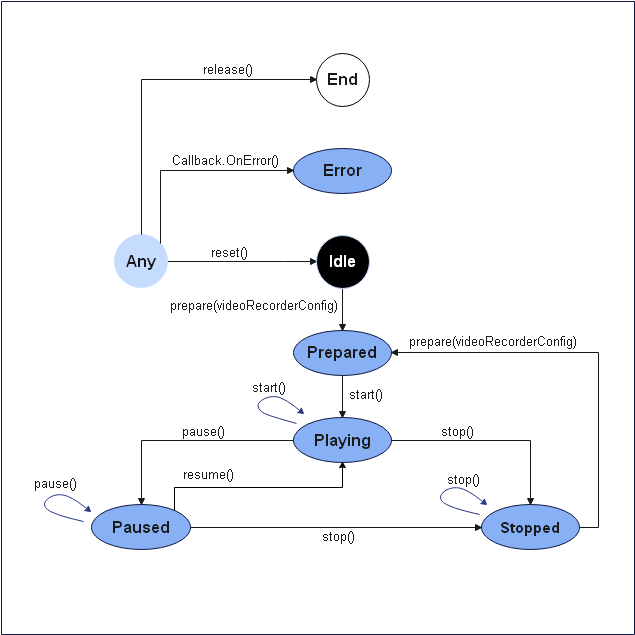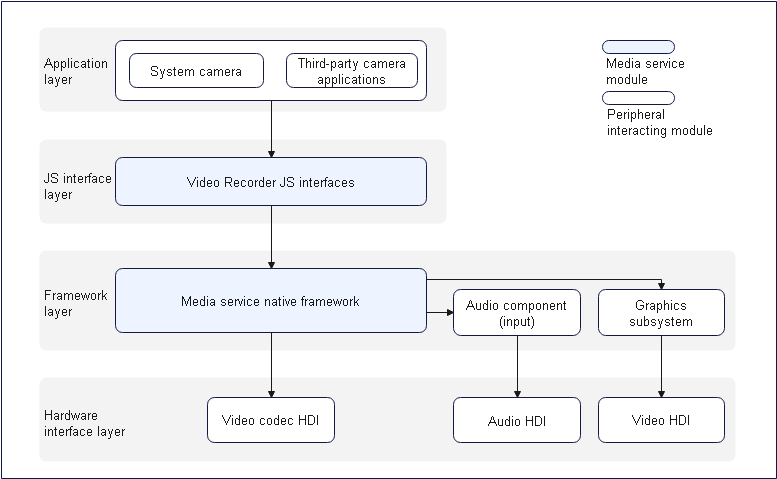Video Recording Development
When to Use
During video recording, audio and video signals are captured, encoded, and saved to files. You can specify parameters such as the encoding format, encapsulation format, and file path for video recording.
Figure 1 Video recording state transition

Figure 2 Layer 0 diagram of video recording

How to Develop
For details about the APIs, see VideoRecorder in the Media API.
Full-Process Scenario
The full video recording process includes creating an instance, setting recording parameters, starting, pausing, resuming, and stopping recording, and releasing resources.
import media from '@ohos.multimedia.media'
import mediaLibrary from '@ohos.multimedia.mediaLibrary'
export class VideoRecorderDemo {
private testFdNumber; // Used to save the FD address.
// pathName indicates the passed recording file name, for example, 01.mp4. The generated file address is /storage/media/100/local/files/Video/01.mp4.
// To use the media library, declare the following permissions: ohos.permission.MEDIA_LOCATION, ohos.permission.WRITE_MEDIA, and ohos.permission.READ_MEDIA.
async getFd(pathName) {
let displayName = pathName;
const mediaTest = mediaLibrary.getMediaLibrary();
let fileKeyObj = mediaLibrary.FileKey;
let mediaType = mediaLibrary.MediaType.VIDEO;
let publicPath = await mediaTest.getPublicDirectory(mediaLibrary.DirectoryType.DIR_VIDEO);
let dataUri = await mediaTest.createAsset(mediaType, displayName, publicPath);
if (dataUri != undefined) {
let args = dataUri.id.toString();
let fetchOp = {
selections : fileKeyObj.ID + "=?",
selectionArgs : [args],
}
let fetchFileResult = await mediaTest.getFileAssets(fetchOp);
let fileAsset = await fetchFileResult.getAllObject();
let fdNumber = await fileAsset[0].open('Rw');
this.testFdNumber = "fd://" + fdNumber.toString();
}
}
// Error callback triggered in the case of an error
failureCallback(error) {
console.info('error happened, error name is ' + error.name);
console.info('error happened, error code is ' + error.code);
console.info('error happened, error message is ' + error.message);
}
// Error callback triggered in the case of an exception
catchCallback(error) {
console.info('catch error happened, error name is ' + error.name);
console.info('catch error happened, error code is ' + error.code);
console.info('catch error happened, error message is ' + error.message);
}
async videoRecorderDemo() {
let videoRecorder = null; // videoRecorder is an empty object and assigned with a value after createVideoRecorder is successfully called.
let surfaceID = null; // Used to save the surface ID returned by getInputSurface.
// Obtain the FD address of the video to be recorded.
await this.getFd('01.mp4');
// Recording-related parameter settings
let videoProfile = {
audioBitrate : 48000,
audioChannels : 2,
audioCodec : 'audio/mp4a-latm',
audioSampleRate : 48000,
fileFormat : 'mp4',
videoBitrate : 48000,
videoCodec : 'video/mp4v-es',
videoFrameWidth : 640,
videoFrameHeight : 480,
videoFrameRate : 30
}
let videoConfig = {
audioSourceType : 1,
videoSourceType : 0,
profile : videoProfile,
url : this.testFdNumber, // testFdNumber is generated by getFd.
orientationHint : 0,
location : { latitude : 30, longitude : 130 },
}
// Create a VideoRecorder object.
await media.createVideoRecorder().then((recorder) => {
console.info('case createVideoRecorder called');
if (typeof (recorder) != 'undefined') {
videoRecorder = recorder;
console.info('createVideoRecorder success');
} else {
console.info('createVideoRecorder failed');
}
}, this.failureCallback).catch(this.catchCallback);
// Call the prepare API to prepare for video recording.
await videoRecorder.prepare(videoConfig).then(() => {
console.info('prepare success');
}, this.failureCallback).catch(this.catchCallback);
// Obtain the surface ID, save it, and pass it to camera-related APIs.
await videoRecorder.getInputSurface().then((surface) => {
console.info('getInputSurface success');
surfaceID = surface;
}, this.failureCallback).catch(this.catchCallback);
// Video recording depends on camera-related APIs. The following operations can be performed only after the video output start API is invoked. For details about how to call the camera APIs, see the samples.
// Start video recording.
await videoRecorder.start().then(() => {
console.info('start success');
}, this.failureCallback).catch(this.catchCallback);
// Pause video recording before the video output stop API of the camera is invoked.
await videoRecorder.pause().then(() => {
console.info('pause success');
}, this.failureCallback).catch(this.catchCallback);
// Resume video recording after the video output start API of the camera is invoked.
await videoRecorder.resume().then(() => {
console.info('resume success');
}, this.failureCallback).catch(this.catchCallback);
// Stop video recording after the video output stop API of the camera is invoked.
await videoRecorder.stop().then(() => {
console.info('stop success');
}, this.failureCallback).catch(this.catchCallback);
// Reset the recording configuration.
await videoRecorder.reset().then(() => {
console.info('reset success');
}, this.failureCallback).catch(this.catchCallback);
// Release the video recording resources and camera object resources.
await videoRecorder.release().then(() => {
console.info('release success');
}, this.failureCallback).catch(this.catchCallback);
// Set the related object to null.
videoRecorder = undefined;
surfaceID = undefined;
}
}